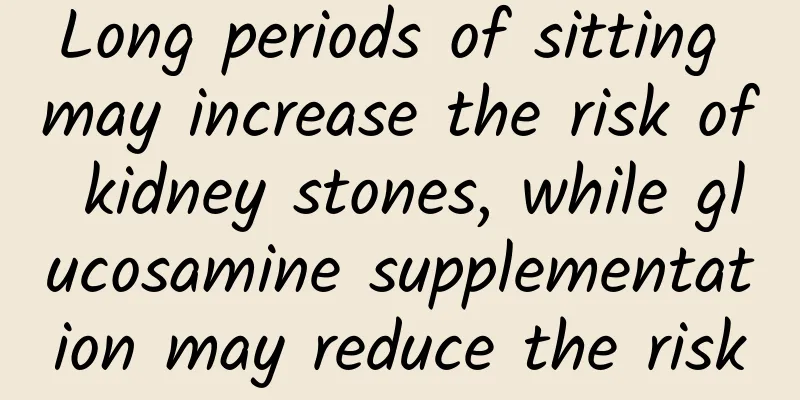Long periods of sitting may increase the risk of kidney stones, while glucosamine supplementation may reduce the risk

|
Kidney stones are a common disease, affecting approximately 10% of adults worldwide, and their global prevalence and incidence are still increasing. Patients with kidney stones are at high risk for metabolic syndrome, cardiovascular disease, chronic kidney disease, and renal failure. Increasing evidence suggests that inflammation plays an important role in the pathogenesis of kidney stones. Therefore, drugs or supplements with anti-inflammatory effects may have potential benefits in preventing kidney stones. (Pictures from the Internet, copyright belongs to the original author) Glucosamine is a commonly used nonvitamin, nonmineral dietary supplement widely used to relieve osteoarthritis and joint pain with potential anti-inflammatory effects. However, to date, no prospective cohort study has investigated the association between glucosamine use and kidney stone risk. In addition, many people like to watch TV or play computer games, and they usually commute by car, and often sit for a long time, which may increase the risk of kidney stones. However, there is currently a lack of prospective cohort studies to explore the association between sedentary behaviors such as watching TV, driving, and using computers and kidney stone risk. In addition, it is unclear whether sedentary behavior affects the relationship between glucosamine use and kidney stone risk. In response to the above clinical problems, Professor Qin Xianhui's team from the National Clinical Research Center for Kidney Diseases of Nanfang Hospital conducted relevant work, and the research results were published in the journal Preventive Medicine . The study found that the longer the total time spent watching TV, driving, using computers and sitting for a long time every day, the higher the risk of kidney stones. Among adults with less sedentary time, the use of glucosamine significantly reduced the risk of kidney stones. Professor Qin Xianhui from the National Clinical Research Center for Kidney Diseases of Nanfang Hospital of Southern Medical University is the corresponding author of the article, and graduate student Gan Xiaoqin is the first author. The study included more than 470,000 middle-aged and elderly participants from the UK Biobank study who had no kidney stones at baseline. The average age was 56.5 years, and 45.3% were male. Among them, 19.2% of the participants reported that they regularly supplemented with glucosamine. After approximately 12.0 years of follow-up, 5,528 (1.2%) participants developed kidney stones. Daily TV watching, driving, computer use, and total sitting time were positively associated with the risk of kidney stones (Figure 1). The risk of kidney stones increased significantly by 18% for those who sat for more than 3.5 hours per day. Figure 1. Daily TV watching (A), driving (B), computer use (C), and total sitting time (D) are all positively correlated with the risk of kidney stones Among people who sat for less than 3.5 hours per day, participants who regularly supplemented with glucosamine had a significant 28% lower risk of developing kidney stones; however, no significant effect of glucosamine use on kidney stone risk was observed among people who sat for more than 3.5 hours per day. At the same time, the genetic risk score for kidney stones had no significant modifying effect on the relationship between glucosamine supplementation and the risk of kidney stones; that is, regardless of whether the genetic risk of kidney stones is high or low, people who sit for less than 3.5 hours a day can reduce the risk of kidney stones by regularly supplementing with glucosamine. This study suggests that reducing sedentary time and supplementing with glucosamine may be a simple, safe and effective strategy to reduce the risk of kidney stones, providing new ideas for the prevention and treatment of kidney stones, but more clinical trials are needed to further confirm this finding. References: Gan X, Zhou C, He P, Ye Z, Liu M, Yang S, Zhang Y, Zhang Y, Huang Y, Xiang H, Qin X. Inverse association of glucosamine use and risk of new-onset kidney stones in UK adults with less sedentary time. Prev Med .2023 Oct 20;177:107738. Editor | Gan Xiaoqin Huang Yu Audit | Qin Xianhui |
<<: What is the relationship between combined detection of HPV and TCT and cervical cancer?
>>: In addition to improving beauty, what other problems can adult orthodontics solve?
Recommend
What to do if your belly sags after childbirth
Many women face a problem after giving birth, whi...
Is it okay for women to always drink coffee?
As one of the three major beverages in the world,...
Meaty granules on the inner side of labia minora
Women should pay special attention to the care of...
The benefits of eating white sesame seeds for women
Sesame is a common nutritious food in daily life....
Why is my menstrual flow so little all of a sudden?
Women's menstrual periods have certain regula...
What is the posture when the fetus moves on the right side?
Baby movement is a very strange thing. Especially...
What is pigmentation during pregnancy?
Many young women will experience significant chan...
What is the cause of uterine distension?
The uterus is a very important organ for women. M...
What are the dangers of cervical hypertrophy?
Cervical hypertrophy is a common cervical disease...
Stop playing with your phone before going to bed, or you might actually go blind...
Every night before going to bed, I turn off the l...
What should I do if I keep coughing? Can quilts spread the virus? 20 questions and 20 answers on home recovery
Source: People's Daily WeChat...
What are the nutritional value and effects of squid shreds? What are the advantages and disadvantages of eating squid shreds?
Squid shreds are rich in nutritional value, mainl...
Protect your child's teeth, don't ignore these 4 types of food
When babies have tooth decay, many parents often ...
What should I do if my period has been delayed for half a month and has not come yet?
Women have their periods for a few days every mon...
Successful pregnancy cases after taking clomiphene
Many couples who are preparing for pregnancy are ...









